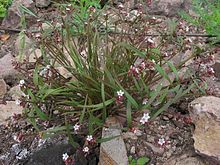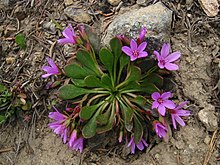Plate herbs
| Plate herbs | ||||||||||||
|---|---|---|---|---|---|---|---|---|---|---|---|---|

|
||||||||||||
| Systematics | ||||||||||||
|
||||||||||||
| Scientific name | ||||||||||||
| Claytonia | ||||||||||||
| L. |
The claytonia ( Claytonia ) are a genus of flowering plants in the family of Montiaceae . Only one of the approximately 26 species is found only outside the New World .
description
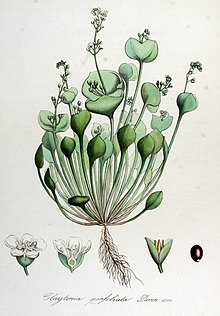

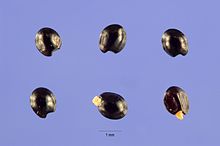
Appearance and leaves
Claytonia usually grow as annual or perennial herbaceous plants ; only Claytonia rubra is a biennial plant . The perennial species form underground tubers, rhizomes or even slightly woody underground stems as persistence organs. The above-ground stems are upright to creeping with bare node ( Nodien ).
The leaves are few to a few in basal rosettes and arranged opposite or rarely in threes in whorls on the stem. The leaves can be more or less succulent . The basal leaves have a linear, lanceolate, obscure-lanceolate, spatulate, deltoid, rhomboid or egg-shaped leaf blade with a blunt or pointed upper end. The stem leaves, which stand together in twos or seldom threes, are free or partially or completely fused with one another or are intergrown by the stem (perfoliate) with a lienal or ovoid leaf blade.
Inflorescences and flowers
The flowers stand together in terminal racemose or dold-like inflorescences . The bracts are foliage-like, membranous or scale-shaped.
The relatively conspicuous, hermaphrodite flowers are radial symmetry and five-fold with a double flower envelope . The five unequal, long-lasting sepals are leaf-like and green. The five petals are often white. There is only one circle with five fertile stamens , the stamens of which are fused with the base of the petals. Three carpels are a spherical, dreikammerigen ovary deformed, the three or six ovules contains. The stylus ends in three pits.
Fruits and seeds
The triple capsule fruits open longitudinally from the upper end and the edges of the compartments are hygroscopic . Each capsule fruit rarely contains one to, usually three to six seeds. The black, shiny seeds are round with a smooth or warty surface and have a white elaiosome . The seeds are spread ballistically ( ballochorie ) or by ants ( myrmecochory ), which are attracted by the elaiosomes.
Chromosome numbers
The basic chromosome numbers are x = 5, 6, 7, 8.
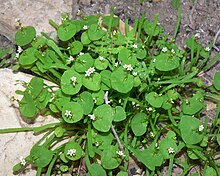

Systematics and distribution
The genus Claytonia was established in 1753 by Carl von Linné in Species Plantarum , 1, p. 204. The scientific generic name Claytonia honors the botanist John Clayton (1694–1773). As lectotype was 1913 Claytonia virginica L. NL Britton and A. Brown in Ill. Fl. NUS , ed. 2, 2, p. 37. Synonyms for Claytonia L. are Belia Steller ex JGGmelin , Limnia Haworth . Some species were previously placed in the genus Montia .
Of the approximately 26 species, around 25 are native to North America , including Mexico, and a few species extend as far as Guatemala in Central America . Some species range from northern North America to northern Russia. Only Claytonia joanneana is only in Altai in Siberia and in the Mongolia is home. In Europe and New Zealand, individual species are neophytes .
There are about 26 Claytonia typologies:
- Claytonia acutifolia Pall. ex Schult. : It occurs in Alaska and northern Russia .
- Claytonia arctica Adam : It occurs in Alaska and northern Russia.
- Claytonia caroliniana Michx. : It is widespread in North America at altitudes between 0 and 1400 meters.
- Claytonia cordifolia S.Watson : It thrives at altitudes of 500 to 2000 meters in British Columbia , California , Idaho , Montana , Nevada , Oregon , Utah and Washington .
- Claytonia eschscholtzii Cham. : It occurs in Alaska and the Russian Far East .
- Claytonia exigua Torr. & A.Gray : The two subspecies are common in western North America.
- Claytonia gypsophiloides fish. & CAMey. : It occurs only in California at altitudes of 100 to 1200 meters.
- Claytonia joanneana Roem. & Schult. : It is the only species thatis native tothe Altai in Siberia and Mongolia outside of the New World.
- Claytonia lanceolata Pursh : It is widespread in North America.
- Claytonia megarhiza (A.Gray) Parry ex S.Watson : It is widespread in North America.
- Claytonia multiscapa Rydb. : It occurs in British Columbia, Alaska, Idaho, Montana, Washington, Wyoming, and northern Russia.
- Claytonia nevadensis S. Watson : It occurs at altitudes of 2000 to 3500 meters in California, Nevada and Oregon.
- Claytonia ogilviensis McNeill : It is endemic to the Yukon at altitudes of around 1500 meters.
- Claytonia palustris Swanson & Kelley : It occurs at altitudes of 500 to 2000 meters in California.
- Claytonia parviflora Douglas ex Hook. : It is native to western North America with four subspecies.
- Common plate herb or Postelein ( Claytonia perfoliata Donn ex Willd. ): The natural range of the three subspecies extends from western North America through Mexico to Guatemala. It is a neophyte in Europe, the Pacific Islands, and New Zealand.
- Claytonia rosea Rydb. : It occurs in Arizona, Colorado, New Mexico , Utah and the Mexican state of Coahuila .
- Claytonia rubra (Howell) Tidestr. : It is native to western North America with two subspecies.
- Claytonia sarmentosa C.A.Mey. : It occurs in British Columbia, Yukon, Alaska and northern Russia.
- Claytonia saxosa Brandegee : It occurs only in California at altitudes of 500 to 2000 meters.
- Claytonia scammaniana Hultén : It occurs in Yukon, Alaska and northern Russia.
- Siberian plate herb ( Claytonia sibirica L. ): It is native to Kamchatka , British Columbia, Alaska, Idaho, western Montana, Oregon, Washington, and northern California.
- Tuberous plate herb ( Claytonia tuberosa Pall. Ex Schult. ): It occurs in British Columbia, in the Northwest Territories , in Yukon, Alaska and Siberia.
- Claytonia udokanica Zuev : It occurs in Siberia.
- Doldiges plate herb ( Claytonia umbellata S.Watson ): It thrives at altitudes of 100 to 3000 meters in California and Oregon.
- Claytonia virginica L .: It is widespread in North America.
- Claytonia × washingtoniana (Suksd.) Suksd. : It is a fertile natural hybrid between Claytonia sibirica and Claytonia perfoliata . It thrives at elevations from 0 to 500 feet in British Columbia, California, Oregon, and Washington.
swell
- John M. Miller: in the Flora of North America , Volume 4, 2003: Claytonia , p. 465 - online with the same text as the printed work , In: Flora of North America Editorial Committee (Ed.): Flora of North America North of Mexico. Volume 4: Magnoliophyta: Caryophyllidae, part 1. Oxford University Press, New York and Oxford, 2003, ISBN 0-19-517389-9 . (Sections Description, Distribution and Systematics)
- John M. Miller, Kenton L. Chambers: Systematics of Claytonia (Portulacaceae). In: Systematic Botany Monographs , Volume 78, 2006, pp. 1-236.
Individual evidence
- ↑ First publication scanned at biodiversitylibrary.org .
- ^ Claytonia at Tropicos.org. Missouri Botanical Garden, St. Louis
